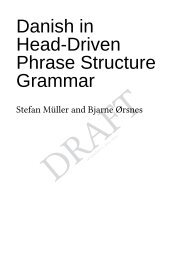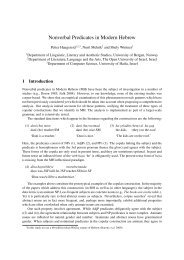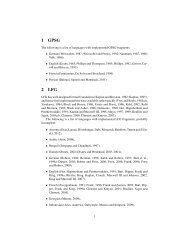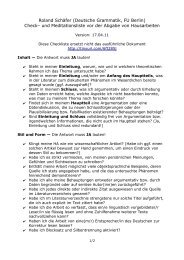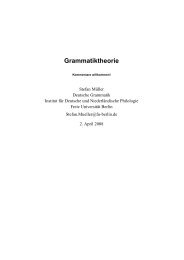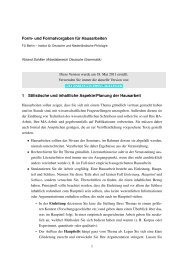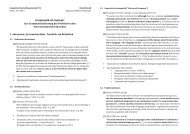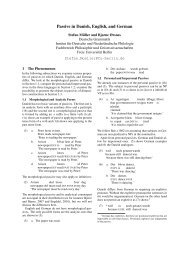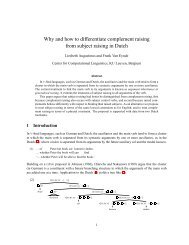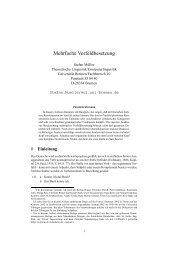Solving the bracketing paradox - German Grammar Group FU Berlin
Solving the bracketing paradox - German Grammar Group FU Berlin
Solving the bracketing paradox - German Grammar Group FU Berlin
Create successful ePaper yourself
Turn your PDF publications into a flip-book with our unique Google optimized e-Paper software.
ST. MÜLLER<br />
(b) Setzt der Fährmann Karl über?<br />
takes <strong>the</strong> ferryman Karl across<br />
‘Does <strong>the</strong> ferryman take Karl across?’<br />
While verb and particle are adjacent in (1a), <strong>the</strong> verb is in initial position in (1b)<br />
and separated from <strong>the</strong> particle. Similarly, whereas verb and particle are<br />
adjacent in (2a), <strong>the</strong>y are separated by <strong>the</strong> ge-prefix of <strong>the</strong> ge- -e-nominalization<br />
in (2b).<br />
(2) (a) Er rennt herum.<br />
he runs around<br />
(b) das Herumgerenne<br />
<strong>the</strong> around.running<br />
‘<strong>the</strong> running around’<br />
Ge- -e-nominalizations of particle verbs can be input to fur<strong>the</strong>r morphological<br />
processes, as is shown by examples like (3), which supports <strong>the</strong> view<br />
that <strong>the</strong>se nominalizations are formed in <strong>the</strong> morphology component.<br />
(3) das Pseudo-Herumgerede<br />
<strong>the</strong> pseudo.babble (Stiebels 1996: 40)<br />
The interesting fact about nominalizations like <strong>the</strong> one in (2b) is that <strong>the</strong><br />
semantic contribution of <strong>the</strong> ge- -e scopes over <strong>the</strong> semantic contribution of<br />
<strong>the</strong> complete particle verb, thus yielding a morphosemantic <strong>paradox</strong>.<br />
In this paper I want to discuss several <strong>bracketing</strong> <strong>paradox</strong>es of a similar<br />
kind and show how <strong>the</strong> problem of <strong>the</strong>se apparent <strong>paradox</strong>es can be solved.<br />
The analysis of <strong>the</strong> inflectional and derivational morphology of particle verb<br />
combinations is based on <strong>the</strong> analysis of <strong>the</strong> syntax of particle verb combinations<br />
developed in Müller (2000).<br />
The paper is structured as follows: in <strong>the</strong> next section, I discuss apparent<br />
<strong>bracketing</strong> <strong>paradox</strong>es in inflectional and derivational morphology. In section<br />
3, I give a very brief introduction to <strong>the</strong> analysis of verbal complexes in<br />
<strong>German</strong> in <strong>the</strong> framework of Head-driven Phrase Structure <strong>Grammar</strong> developed<br />
by Pollard & Sag (1994). In section 4, I repeat <strong>the</strong> analysis of particle<br />
verb combinations in syntax that was suggested in Müller (2000) and, in<br />
section 5, I show how <strong>the</strong> morphological facts can be explained within <strong>the</strong>se<br />
assumptions. In section 6, I discuss alternative proposals.<br />
2. T HE PHENOMENON<br />
The morphological facts that will be discussed in <strong>the</strong> following subsections<br />
suggest that inflectional and derivational material always attaches to <strong>the</strong><br />
verbal stem in verb particle combinations. On <strong>the</strong> o<strong>the</strong>r hand, this material<br />
always scopes over <strong>the</strong> meaning contribution of <strong>the</strong> entire particle verb or<br />
276




